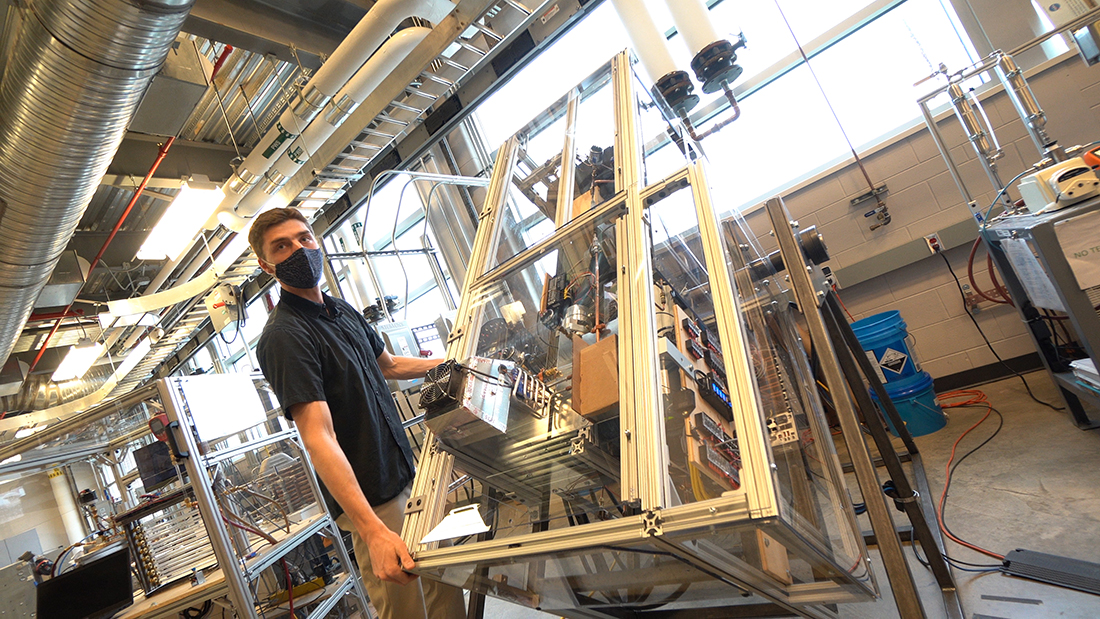A refrigerator for cold storage is just one of many things astronauts will need as they journey farther into space. The typical household fridge, however, is not designed to work in the absence of Earth’s gravity. From May 4 through 7, 2021, researchers from the small manufacturing company Air Squared, Purdue University, and Whirlpool Corporation completed a parabolic flight campaign with Zero Gravity Corporation in Fort Lauderdale, Florida, to test the gravity independence of a system that could keep food fresh for years at a time.
The vapor compression refrigeration technology demonstration system is about the size of a large microwave oven, though the same cooling technology could be used in refrigerator cabinets several times as large. Designed primarily for food storage, it could also help preserve biological samples for science experiments. Uniquely, its oil-free scroll compressor could make it reliable in any orientation, like upside down or on its side – an important capability for the variable gravity of lunar and planetary missions.
Headquartered in Broomfield, Colorado, Air Squared received funding for the refrigeration technology through Phase I and II awards from NASA’s Small Business Innovation Research (SBIR) program. It was later bolstered by investments from NASA’s Johnson Space Center in Houston and Whirlpool Corporation in Benton Harbor, Michigan, as well as NASA’s Flight Opportunities program, whose support of Air Squared’s SBIR Phase II-Extended award included the recent flight tests. The technology’s ongoing research and development is part of the agency’s Advanced Exploration Systems Logistics Reduction and Repurposing project at NASA Johnson, which evaluates technologies that may be useful on future missions to Mars.
Each of the four parabolic flights provided the research team brief periods of microgravity, while also allowing them to be present to tend to their payloads during flight. The team evaluated the vapor compression cycle, a conventional method for cooling in everyday refrigerators on Earth that usually depends on the behavior of liquid and vapor in gravity. This demonstration resulted in the first ever documentation of vapor compression refrigeration in a parabolic or suborbital environment, providing critical data to mature the technology for potential future use on space exploration missions.
“It’s one thing for us to collect microgravity data and verify that the system is maintaining cooling,” said Dr. Stephen Caskey, principal investigator for the flight demonstration. “But it’s another thing to identify potential issues and then predict them so we can find workarounds. The feedback we’ve received from NASA and the parabolic testing we’re doing is helping us toward that goal.”
About Flight Opportunities
The Flight Opportunities program is funded by NASA’s Space Technology Mission Directorate (STMD) at the agency’s Headquarters in Washington, and managed at NASA’s Armstrong Flight Research Center in Edwards, California. NASA’s Ames Research Center in California’s Silicon Valley manages the solicitation and evaluation of technologies to be tested and demonstrated on commercial flight vehicles.
About NASA SBIR/STTR
NASA’s SBIR/Small Business Technology Transfer (STTR) program, also within STMD, funds the research, development, and demonstration of innovative technologies that fulfill NASA needs as described in the annual solicitations and have significant potential for successful commercialization. The program is open to small businesses with 500 or fewer employees and to non-profit research institutions, such as universities or research laboratories, with ties to small businesses.
By Elizabeth DiVito
NASA’s Flight Opportunities program

































